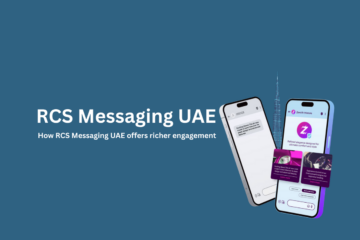A customer clicks “reset password” and waits for the code. A logistics company wants to update thousands of buyers about their delivery schedules. One of the retailers makes a sale, and the sale is made during a day. In all these instances, the single medium that can be used in all circumstances, whether an individual has internet or not, is SMS.
The aspect that differs is the way the businesses actually deliver those texts. Rather than purchasing their own gateways and negotiating with domestic carriers, an increasing number of businesses will currently depend on a cloud-based SMS gateway. These platforms allow teams to make messages at scale, across borders, without actually touching telecom hardware. For businesses that value speed, cost control, and reliability, that shift has become hard to ignore.
What We Mean by “Cloud-Based SMS Service”
Fundamentally, cloud SMS runs on remote servers. Businesses do not have to install equipment, negotiate with different carriers, or handle complex configurations. They are interconnected over API or a web dashboard, and the service performs the heavy lifting, routing, delivery, reporting, and compliance.
Consider using Gmail instead of having your own email server. You can create a running one, but most people would be content to entrust Google with the complexity. A cloud-based SMS service works the same way, except the “inbox” is every phone on the planet.
These platforms usually come with:
- APIs for developers who want messaging built into apps or websites
- Bulk messaging tools for campaigns and alerts
- Delivery receipts and analytics
- Add-ons like WhatsApp Business API or voice calls
- Built-in compliance with local regulations
Why Businesses Are Switching
If traditional gateways still work, why move? The reasons are practical.
- Global reach. A local provider might serve one or two countries. Cloud SMS services often cover hundreds.
- Flexibility. Send 500 messages this week and 500,000 next week without changing setup.
- Resilience. If one delivery route fails, the system quietly uses another.
- Savings. No servers, no IT team for telecom hardware, no software licenses. Just pay for what you use.
- Regulatory safety net. Every country has different SMS rules. Providers keep up so businesses don’t have to.
The appeal isn’t theory—it’s what companies experience daily when customers actually receive their messages on time.
A Banking Example: OTPs That Don’t Lag
Banks were among the earliest adopters. One major European bank used to manage its own SMS gateway. However, when there was high traffic, OTPs (one-time passwords) were slow to arrive or not received at all. Customers got frustrated, call centers were swamped with complaints, and trust was lost.
When the bank moved to a cloud SMS provider, the change was immediate. Delivery success jumped by double digits. Costs went down because they weren’t maintaining hardware. And, most of all, customers ceased to complain about delayed OTPs. That one change to the transfer to the cloud, has addressed the issue that has been leaking resources over the years.
The SMSala Example
Among global providers, SMSala has made a mark. The company works with over 5,000 enterprise customers worldwide. Their clients rely on them not just for SMS but also for the WhatsApp Business API and Voice Messaging services.
The value here is simplicity. Instead of juggling five different regional vendors, a business plugs into SMSala’s platform and gets unified access to carriers around the globe. For teams running OTPs, marketing pushes, or customer alerts, that kind of consistency is more valuable than squeezing out another penny of savings.
How It Differs from Old-School Gateways
The shift becomes clearer when you compare the old with the new:
- Traditional gateways mean installing boxes, handling contracts, and assigning IT staff.
- Cloud SMS means logging into a dashboard or hitting an API endpoint.
There is a difference between having your own fleet of trucks and using FedEx. Yeah, with trucks, you have control, but the price, maintenance, and complexity would offset this in many cases. For most businesses, renting the delivery power of a global network makes far more sense.
How the Tech Works?
The process isn’t complicated for users, though behind the scenes it’s a web of carrier connections.
- A business system (like an app or CRM) sends a request to the cloud SMS API.
- The provider’s platform decides the best delivery path—choosing carriers and routes.
- The carrier pushes the SMS to the phone.
- A delivery receipt is sent back to the business.
That’s it. From the developer’s point of view, it’s one API call. From the customer’s point of view, it’s a message that arrives in seconds.
Where Companies Use It
- Retailers run bulk promotions and see immediate response.
- Banks and fintech firms handle two-factor authentication.
- Hospitals remind patients about appointments.
- Governments issue alerts for emergencies.
- Logistics firms update customers on parcel status.
The unifying theme? SMS still works when apps, push notifications, or emails don’t.
Blending SMS With WhatsApp
Here’s where strategy gets interesting. Businesses don’t always choose between SMS and WhatsApp—they often use both.
Take airlines. They might text flight times via SMS (since everyone gets texts), then send boarding passes over WhatsApp (where media and buttons are supported). The mix guarantees reach and offers richer interaction where possible.
Cloud platforms like SMSala allow companies to combine bulk SMS service with WhatsApp Business API under one umbrella, so there’s no need to manage them separately.
A Story From E-Commerce
One e-commerce startup in Southeast Asia learned this lesson the hard way. They had five different SMS vendors across five countries. Delivery times varied wildly. Sometimes promotions reached customers hours late, which meant sales were lost.
After moving to a cloud-based service, they managed all messaging through one API. Campaign speed doubled. Complaints dropped. Delivery rates improved. The switch wasn’t glamorous, but it saved money and kept customers engaged.
Data as a Byproduct
Cloud SMS providers don’t just send texts—they show patterns. Marketers can see which regions get better engagement, which times of day perform best, and which campaigns flop.
In the past, businesses sent SMS into the void. Now they can actually measure what works and refine strategies like they do with email or social ads.
Navigating Compliance
SMS isn’t the Wild West. Europe has GDPR, the U.S. has TCPA, India has TRAI. Each comes with fines for violations. For a global business, tracking every regulation is nearly impossible.
Cloud providers handle it automatically. Non-compliant messages are filtered, and updates are pushed system-wide. That way, businesses can focus on communication, not legal footnotes.
Pricing That Actually Fits
Traditional gateways demanded upfront investment—servers, licenses, staff. That’s before a single text was sent. With a cloud-based SMS service, pricing is straightforward: pay only for the messages sent.
This has lowered the barrier for small businesses and startups. They don’t need a big budget to send SMS campaigns; they can scale costs with growth.
Looking Ahead
The direction is clear. SMS isn’t disappearing—it’s evolving. Expect to see:
- Chatbots that work directly over SMS or WhatsApp
- Two-way conversations where customers reply, not just receive
- Campaigns tied into CRM data for personalization
- SMS triggering follow-ups across email or WhatsApp
The role of SMS is expanding from a blunt alert tool to part of a larger, more thoughtful customer journey.
Wrapping It Up
The move to a cloud-based SMS service isn’t about hype—it’s about practicality. Banks want faster OTPs, retailers want reliable campaigns, and governments need emergency alerts. SMS still does that better than almost any channel, and the cloud makes it possible to do it at scale, across borders, without headaches.
Companies like SMSala, with their mix of Bulk SMS, WhatsApp Business API, and Voice Messaging, are showing what it looks like when messaging just works. For businesses weighing whether to modernize communication, the answer isn’t if—it’s when.



